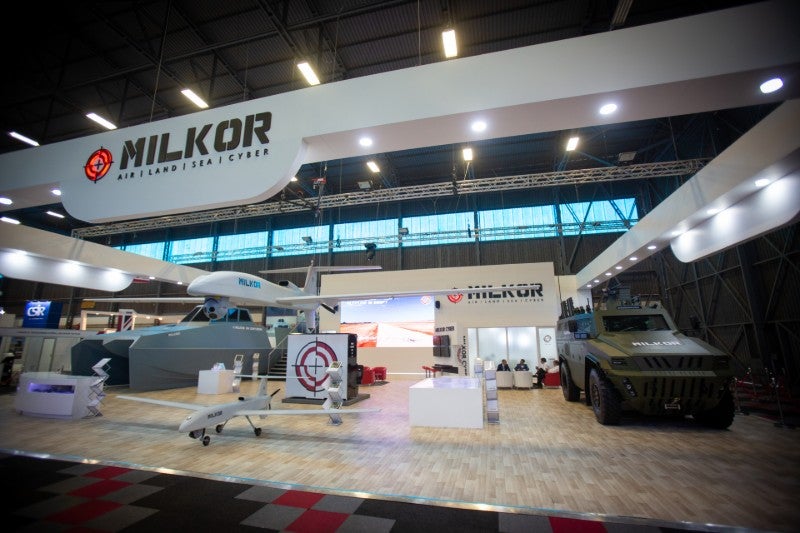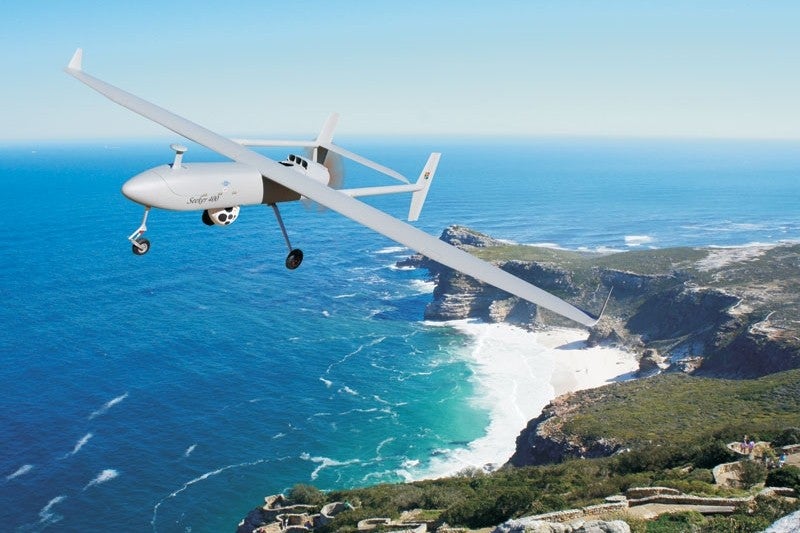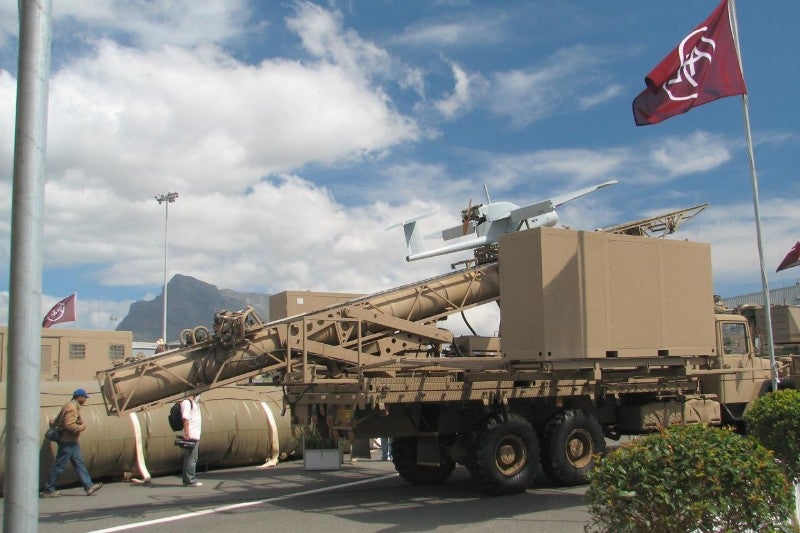
The market for South African military unmanned aerial vehicles has been hotting up recently, with the demonstration of Milkor’s drone array – including the new Milkor MA380 – dominating last year’s African Aerospace and Defence exhibition, as well as the Defense Services Asia Exhibition and Conference 2018 in Malaysia.
Four companies – Milkor, Denel Dynamics, CSIR and ATE – have all developed South African military unmanned aerial vehicles concepts, ranging from hand-launched drones with intelligence, surveillance and reconnaissance (ISR) functions to larger armed unmanned aircraft.
What types of drones does each company offer and how do their capabilities differ?
Milkor: MA380, MA80, MA18
At various defence aviation events last year, Milkor showcased its latest drone array including the Milkor MA380, MA80 and MA18.
The largest drone of the group – the Milkor MA380 – was designed for long-endurance missions such as search-and-rescue operations, ISR, and maritime patrol. As such, it has a flight endurance time of around 20 hours and can travel at distance of more than 2000km. It also operates a cruise speed of 150km/h and cruise altitude of 14,000ft, but can reach speeds of up to 220km/h in short bursts.
The MA380 is equipped with hardpoints under each wing that can be fitted with armaments and optronic equipment integrated through the gyro-stabilised gimbal under the nose, which sends real-time images and videos to the ground control staff. In total, it has a payload-carrying capacity of up to 80kg.
The smaller MA80 is similar in design, with greater endurance of 24+ hours, but a maximum range of only 250km. Its wingspan is half the size of the MA380 at 6m, and it is capable of carrying much smaller payloads of around 15kg.
The hand-launched MA18 can be easily disassembled and carried around in a backpack. While the MA18 only weighs 3kg, according to a Milkor spokesperson, it can carry small payloads of 300g. It has an endurance of around 90 minutes at a range of less than 30km and can cruise at a speed of around 50km/h.
Denel Dynamics: Seeker 400, Hungwe, Skua

Some form of the Denel Seeker unmanned aerial vehicle has been used since the early 1980s, during the War of Namibian Independence.
The latest Seeker 400 variant, evolved from the battle-tested Seeker II used by the South African, Algerian and UAE air forces, is a multi-mission multi-role drone that provides enhanced ISR capabilities, as well as payload carrying of up to 100kg and artillery fire control. It has the optional capacity to be fitted with a laser guided missile with a stand-off range of up to 10km.
One of the key features of the Seeker 400 is its electro-optical sensor suite in the form of a nose gimbal, which will include colour daylight and infrared thermal cameras, a night spotter camera, a laser rangefinder and laser designator, and an electronic surveillance payload for detecting radar emitters. The Seeker 400 successfully passed its first flight test in 2014.
The Hungwe unmanned aerial vehicle is a catapult-launched drone that can be fitted with day or night payload sensors and includes an onboard communications link that can transmit real-time information to a base up to 100km away. It offers an endurance of six hours and has a service ceiling altitude of 12,000ft, carrying a small 5kg payload.
In the military, it is used mainly for border patrol activities, anti-piracy maritime operations, battlefield support and search-and-rescue missions.
Denel’s Skua target drone was designed to mimic fast attack aircraft and is thus used for testing weaponry, such as Denel’s own Umkhonto surface-to-air missile and the Brazilian-made MAA-1 Piranha air-to-air missile.
To this end, the Skua reach speeds of Mach 0.86 (1,062km/h) at an altitude of around 32,800ft. According to Denel, the endurance of the Skua is 60 minutes at a speed of Mach 0.7 (865km/h) and an altitude of roughly 20,000ft.
Other South African military unmanned aerial vehicles

The Indiza unmanned aircraft system, developed by CSIR/Defsec, is a hand-launched rugged mini-drone designed to incorporate three different camera modules, specifically a pan, tilt and stow twin-camera system, a stowable high-definition wide angle video camera, and a 3G mobile phone-based camera.
It has a GPS-based autopilot feature, radio modem, and video transmitter. On the ground, operators use a laptop-based mission planner with data link modem and tracking antenna to receive real-time data from the Indiza. The Indiza has been wind tunnel tested, which is rare for unmanned aircraft systems. In March 2019, Defence Web reported that the South African National Defence Force is testing the Indiza for use in peacekeeping operations in the Democratic Republic of Congo.
Finally, the Vulture unmanned aerial vehicle developed by Advanced Technology and Engineering (ATE) is a catapult-launched, fully automated high mobility drone used for coastal surveillance, medium-range ISR, and border patrol. The South African Army uses the Vulture for artillery target acquisition and fire correction purposes.
Vulture is one of the older South African military unmanned aerial vehicles; ATE began producing it back in 2006. It features an interchangeable near-infrared (NIR) or forward-looking infrared radiometer (FLIR) day and night camera, as well as a digital DSSS secure data link to send information and holds a gyro-stabilised electronic sight as its payload, and a synthetic aperture radar as an additional payload.
For around four hours, the Vulture can loiter at a cruise speed of 120km/h at a range of 60km, up to a maximum altitude of 5,000m. The Vulture does not need a runway as it is launched from a Samil 100 military truck.



